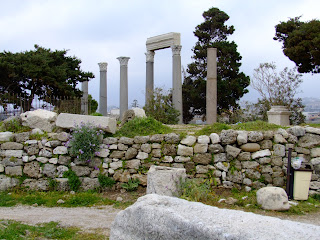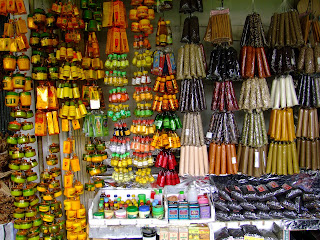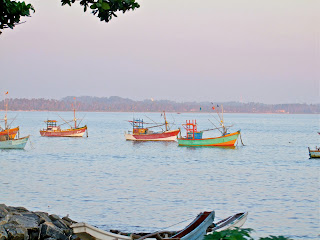 New Plymouth is a city nestled on the west coast of the North Island, in the province of Taranaki and is geographically dominated by the nearby imposing majesty of Mount Taranaki ( formerly Mt. Egmont ), a 2518 metre high conically shaped volcano. It is deemed an active volcano with activity averaging every 90 years and a major eruption every 500 years. The last activity was around 1850. Most of the year it is snow covered and when visible ( often it is obscured by cloud ) is awesome and beautiful.
New Plymouth is a city nestled on the west coast of the North Island, in the province of Taranaki and is geographically dominated by the nearby imposing majesty of Mount Taranaki ( formerly Mt. Egmont ), a 2518 metre high conically shaped volcano. It is deemed an active volcano with activity averaging every 90 years and a major eruption every 500 years. The last activity was around 1850. Most of the year it is snow covered and when visible ( often it is obscured by cloud ) is awesome and beautiful.Our previous ventures to New Plymouth have been to attend the Womad festival which is held yearly in the beautiful Pukekura Park. Womad is a wonderful 3 day festival of music and culture from around the world. Hosted in many countries the New Plymouth Womad is often said to be the best Womad venue anywhere. We have been a few times and it has always been a fantastic weekend.
 This last weekend however we were in New Plymouth to attend the funeral of my cousin Bill. Very sadly Bill had passed away not too far off his 62nd birthday.
This last weekend however we were in New Plymouth to attend the funeral of my cousin Bill. Very sadly Bill had passed away not too far off his 62nd birthday.At age 22 Bill suffered kidney failure. He had 40 years living an unfathomably difficult life, several transplants, all of which failed, many operations and many years of having to hook up to a dialysis machine every 2 days. 40 years of health intervention ruling his life daily yet despite this he had an outlook on life that was inspirational.
Right up to the end he lived his life without complaint of his condition, rather, he looked at all the positives in his life - his love for his wife Phillipa and their children, Kate, Mathew and David, his extended family, friends and his career ( as a guidance councillor at New Plymouth Boys High School ) were all foremost in his thoughts and his daily life. He put his disability to one side and got on with the good things he had in life.
Glowing tributes were paid to him from so many of his colleagues, friends, family and boys that he had inspired from his school. Inspirational was a word often used by those who spoke about this larger than life, formidable gentleman.
Rest in Peace Bill. You were a rare person in the lives of all who knew you.
 New Plymouth, even now without Bill, is a great place to visit. Being on the coast and having the mountain so close geography is big on the attraction list. With surf beaches, coastal rivers emptying to the sea, estuaries, the mountain and lush green rolling farmland and small towns there is much to do and explore.
New Plymouth, even now without Bill, is a great place to visit. Being on the coast and having the mountain so close geography is big on the attraction list. With surf beaches, coastal rivers emptying to the sea, estuaries, the mountain and lush green rolling farmland and small towns there is much to do and explore. The city itself is very walkable and the one thing that strikes you are the large artworks on building walls, the streets and parks.
The city itself is very walkable and the one thing that strikes you are the large artworks on building walls, the streets and parks. Art is very big in New Plymouth and high on the list of must sees is the Govett - Brewster Art Gallery housing many works of kinetic sculpture from Len Lye. These installations are large perpetual motion pieces commonly in stainless steel. They wave, or wobble, or rotate and seem to have an infinite life of their own. The gallery building is an architectural statement in itself with tall multi-curved reflective stainless steel walls - very impressive inside and out.
Art is very big in New Plymouth and high on the list of must sees is the Govett - Brewster Art Gallery housing many works of kinetic sculpture from Len Lye. These installations are large perpetual motion pieces commonly in stainless steel. They wave, or wobble, or rotate and seem to have an infinite life of their own. The gallery building is an architectural statement in itself with tall multi-curved reflective stainless steel walls - very impressive inside and out.
 The coastal walkway is right beside the city centre and a walk along here is a must. Again there are artworks and installations all around and an abundance of restaurants and cafes to enjoy on your way.
The coastal walkway is right beside the city centre and a walk along here is a must. Again there are artworks and installations all around and an abundance of restaurants and cafes to enjoy on your way. Such a vibrant and friendly city, New Plymouth should be on your list of places to visit if you are in New Zealand. Best times to visit would be in March for Womad when the weather is still warm, or Spring ( September ) where the mountain still has a full covering of snow, the temperatures are cool to warm but fresh and new born lambs and calves can be seen amid the lushness of the countryside. If you come to New Plymouth from the north then do try and stop at Awakino, Mohau and Tongaporutu for stunning coastal and estuarine landscapes and you must try the Whitebait Fritters on offer at most cafes. Delicious.
Such a vibrant and friendly city, New Plymouth should be on your list of places to visit if you are in New Zealand. Best times to visit would be in March for Womad when the weather is still warm, or Spring ( September ) where the mountain still has a full covering of snow, the temperatures are cool to warm but fresh and new born lambs and calves can be seen amid the lushness of the countryside. If you come to New Plymouth from the north then do try and stop at Awakino, Mohau and Tongaporutu for stunning coastal and estuarine landscapes and you must try the Whitebait Fritters on offer at most cafes. Delicious.There are many places to stay in New Plymouth. We can highly recommend One Burgess Hill which is sited on a large property in the countryside just out of New Plymouth on the road to Startford and Wanganui.
Nestled amongst hills beside a flowing boulder lined river, with paddocks of sheep ( and baby lambs whilst we were there ) and cows. A number of accommodation blocks are scattered around the estate. Much thought has gone into the design of the buildings and the landscaped grounds that surround them. The river walk and a leisurely stroll around the property is recommended.

 The rooms themselves were very stylish and comfortable. A variety of layouts and prices are on offer. Ours at the cheapest end was still very up market with a deliciously deep spa bath to relax in and soak at the end of the day. A huge comfortable bed, T.V. with full Sky and free wi-fi are standard. All rooms have kitchen facilities and a variety of breakfast options can be provided if required.
The rooms themselves were very stylish and comfortable. A variety of layouts and prices are on offer. Ours at the cheapest end was still very up market with a deliciously deep spa bath to relax in and soak at the end of the day. A huge comfortable bed, T.V. with full Sky and free wi-fi are standard. All rooms have kitchen facilities and a variety of breakfast options can be provided if required.
























































